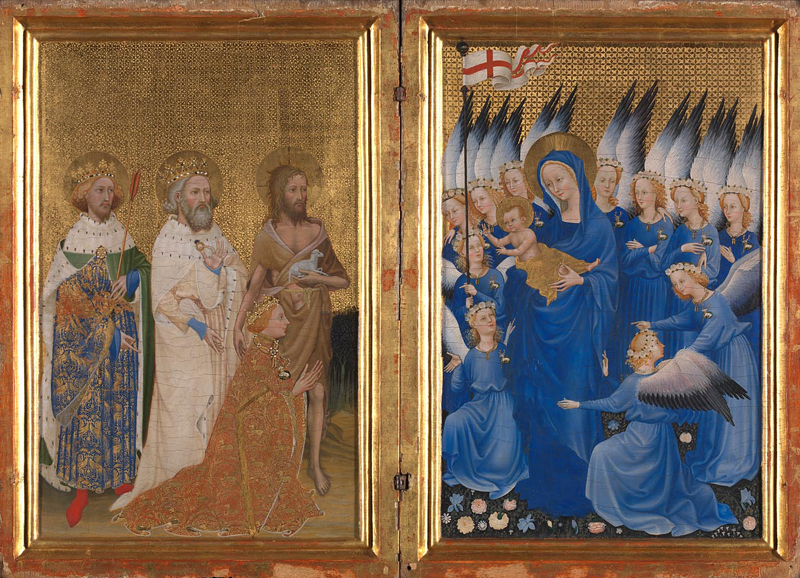Second Sunday of Lent

The Wilton Diptych
about 1395-9
Egg on oak, 53 x 37 cm
Bought with a special grant and contributions from Samuel Courtauld, Viscount Rothermere, C.T. Stoop and the Art Fund, 1929
NG4451
https://www.nationalgallery.org.uk/paintings/NG4451
A Diptych is a hinged, two-panel painting. Although both panels may make up a single scene, they are often separate images that are nonetheless connected thematically. Typically, one panel only finds its meaning when compared to the next.
An example is the Wilton Diptych (c. 1395-1399). It was a kind of portable altar used by King Richard II of England. Although painted when the king was middle-aged, it shows him aged ten when he was crowned, kneeling in a desert. Above him are his three patron saints. The four face the second panel depicting the Madonna and Christ Child. Mary stands in a flowering meadow surrounded by angels.
The key to the two panels is the king giving an English flag under a globe with an island on it to Mary – the king is giving his kingdom to her protection. Each panel of the Wilton Diptych would be intelligible on its own. Yet the full meaning of the artwork only arises when together.
Similarly, the Transfiguration account today taken alone could give us a mistaken idea about prayer and discipleship. Here Jesus goes up a mountain with his inner circle of disciples. He prays to His Father and, behold, His countenance manifests divine light. Then Moses and Elijah, who had once almost seen God’s glory, appear and see it fully now. Finally, the Father’s voice affirms Christ’s divine Sonship. The Transfiguration becomes the moment when Jesus dedicates Himself to the Father’s will completely.
Again, the Transfiguration taken alone cannot give us its deepest meaning. Benedict XVI states, “the verification of the Transfiguration is, paradoxically, the Agony in Gethsemane [cf. Mt. 26:36-46]. With his impending Passion, Jesus was to feel mortal anguish and entrust himself to the divine will.” When the Transfiguration and the Agony in Garden are viewed side by side they form a spiritual diptych. Only when Jesus feels distant from the Father is the significance of the Transfiguration revealed. At this other mountain event, Christ hears no consoling words, His disciples are aloof to His grief, and He reasserts His commitment to God’s will even as He struggles to accept it.
Without Gethsemane hinged to the Transfiguration, we might be tempted to think that Lent – and indeed prayer – were about seeking intense spiritual experiences. We tend to prize the extraordinary, the emotional, and the spontaneous. Like Peter, we want to enshrine gifts given in prayer. Yet, as Fr. Armand Veilieux, OCSO, writes, “even the most extraordinary experience of God is usually only the first step on a long journey toward conversion.” It is good to experience the Father’s abundant love personally. All the same, what is better for discipleship is consistency in prayer. Better to do a little less than we find impressive with regularity than random exciting attempts. God’s will is often hard and prayer may be dry. Still, I can ask, did I go to prayer for God Himself or to feel good?
In Mark’s gospel immediately after the Transfiguration, the scene opens onto the other apostles failing to exorcise a demon. When the Twelve ask Jesus privately why they could not heal the possessed boy and He could, He says plainly: “This kind can only come out through prayer” (9:29). The extraordinary is only preceded by the consistent.
Reflection Question: What would a consistent and faithful spiritual life look like for me? When am I going to God to feel good or for spiritual gifts, instead of for God Himself?
Reflection by Fr. Pachomius Meade, OSB
Posted in Articles for Lent, Daily Reflections, Lenten Resources

